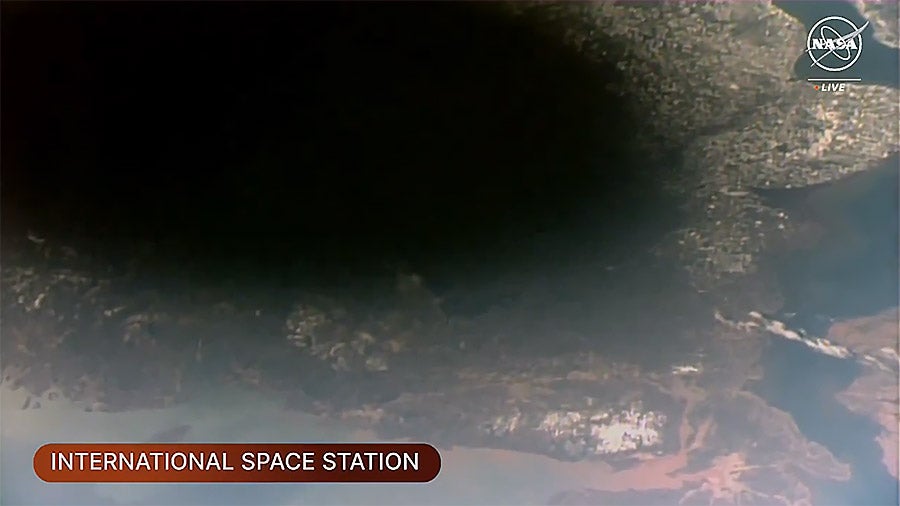A total eclipse of the Sun plunged a stretch of North America into darkness on Monday, with millions of spectators across the US, Mexico and Canada hoping to catch a glimpse of the rare event.
It was North America’s biggest eclipse crowd ever, with the path of totality crossing directly over 44 million people.
More were drawn in from across the world thanks to the lure of clear skies and up to four and a half minutes of midday darkness in some places.
Almost everyone in North America was guaranteed at least a partial eclipse, weather permitting.
The best weather was seen in Mexico and at the tail end of the eclipse in Vermont and Maine, as well as New Brunswick and Newfoundland.
“Cloud cover is one of the trickier things to forecast,” National Weather Service meteorologist Alexa Maines explained at Cleveland’s Great Lakes Science Centre on Sunday. “At the very least, it won’t snow.”
ISS astronauts photograph Moon’s shadow on Earth
Nasa astronomers Matthew Dominick and Jeanette Epps took photographs and videotaped the Moon’s shadow on Earth as the International Space Station (ISS) passed between the Moon and the Earth.
The ISS was orbiting 260 miles above southeastern Canada as the Moon’s shadow, or umbra, was moving from New York state into Newfoundland, according to Nasa.

The orbiting laboratory experienced a totality of about 90 per cent during its flyover period.
Google search for ‘eyes hurt’ spikes after eclipse
There was an uptick in Google search terms like “eyes hurt” and “my eyes hurt” around 2pm ET as the solar eclipse passed over North America.
Nearly 32 million people were on the path of the totality, including parts of US states Texas, Oklahoma, Arkansas, Ohio, Pennsylvania, New York, and Maine as the rare celestial phenomenon occurred.
It will not be another two decades until the next total solar eclipse covering such major parts of the US occurs.
Looking at the sun without protective glasses can be harmful to vision, with complaints of eye problems documented even after previous eclipses.
Ophthalmologists say two main types of injuries may occur if one looks at the sun directly – burn to the outside of the eye, which is called solar keratitis, or damage to nerve tissue within.
“You can get sort of a burn to that cornea, and that’ll cause redness and tearing and those sorts of symptoms. That should resolve on its own, within a day or two, without any sort of permanent damage,” Daniel Lattin, an ophthalmologist in Florida, told NBC News.
Doctors cautioned ahead of the eclipse that people experiencing discomfort following eclipse viewing must seek medical help.
“See a local doctor of optometry for a comprehensive eye exam if you experience discomfort or vision issues post-eclipse,” the American Optometric Association said.
Scientists observe animal behaviour changes during eclipse
Zookeepers and scientists documented unusual behaviour among animals including, gorillas, giraffes, macaws and flamingoes during the total solar eclipse.
Since total solar eclipses are rare, researchers observed animals on Sunday evening at zoos including the San Antonio Zoo and the Fort Worth Zoo in the US.
The San Antonio Zoo shared a video of meerkats running erratically throughout their habitat “as one large group” during totality.
“Meerkats approaching and entering their indoor habitat space in the few minutes prior to totality, which supported our working hypothesis that diurnal animals, meaning those awake during the day, would display their typical evening activity patterns during totality!” the zoo’s official X account posted.
As the skies darkened, many animals in the Forth Worth zoo reportedly made their way through their barn doors, which the creatures usually do at night.
Birds also showed behaviour changes in some zoos.
An Indianapolis Zoo spokesperson told CBS News that macaws, budgies and other birds got quiet and roosted up high, displaying nighttime behaviour during the eclipse.
What are the next celestial events to look forward to?
The eclipse is over, but the millions who watched it in North America don’t have that long to wait for the next celestial event.
Later this month will see the Lyrids Meteor Shower, before the Eta Aquarids light up the sky in May. In July, the Perseid meteor shower will rain shooting stars, while star gazers can also look forward to a partial lunar eclipse in September and an annular solar eclipse in October.
You can find out more about the next night-sky events here:
Here’s what the solar eclipse looked like in the path of totality
‘What was the experience like watching it? Eudaimonia,’ one person who’d travelled eight hours to see the total solar eclipse in Vermont told Amber Jamieson.
Weather Channel goes wild for solar eclipse
A clip from the Weather Channel has been doing the rounds after the presenter got very excited by the totality.
Stephanie Abrams was in Fredericksburg, Texas, when the total solar eclipse appeared from behind the clouds.
She can be heard screaming through the darkness: “We got it! Oh my god, it’s just so amazing.”
You can watch it here:
Black spot appears over Earth
It’s not only the International Space Station offering views of today’s solar eclipse – a satellite from SpaceX’s Starlink network caught the moment a black spot appeared over Earth.
Niagara Falls plunges into darkness
Local outlet WIVB-TV has shared footage of the moment Niagara Falls fell into darkness in the middle of the day.
The solar eclipse, whose path of totality passed right over the border town, caused street lights to automatically switch on.
‘I was about to cry’ says top astrophysicist in Montreal
“We were in connection directly with the universe, with the sun, with the moon, and we are so humble to see that.”
Minutes after the moon blotted out the sun for 90 surreal seconds on an island in the St Lawrence River, Olivier Hernandez, director of the Montreal Planetarium and a noted astrophysicist, was almost in tears.
“It was so emotional I was about to cry. Did you see the corona? Did you see the purity of the light coming out from the sun? We have seen also the chromosphere,” he said
“Wow, what a show, what a show.”
In the Great American Eclipse of 2024, Montreal was the star turn that no one had predicted. Most astronomical attention along the “zone of totality” was focused on Texas and the Midwest, with Niagara Falls also hoping for clear skies over one of the world’s great tourism icons.
In the end, though, the corrugated skyline of Canada’s biggest French-speaking city was the backdrop to a cosmic show that was summed up again and again as extraordinaire.

Source: independent.co.uk



